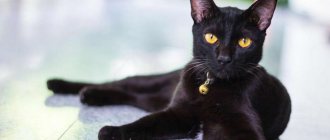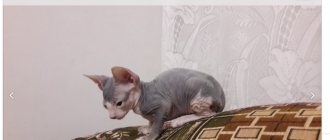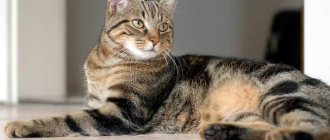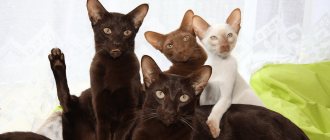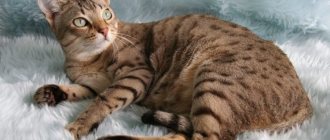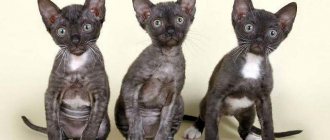Origin story
The history of Burmese cats began a long time ago.
The first mentions of luxurious tailed creatures of unusual color date back to the 12th century, and a little later - in the 12th-18th centuries - they received several stanzas in the “Poem about Cats”. Miniature, fine-boned, with huge honey-colored eyes, the Burmese were highly valued in majestic Siam. They were singled out from the entire cat family: they were allowed to enter temples and were fed tasty and satisfying food. The monks personally looked after the representatives of the breed, believing that it was the Burmese cats that escorted the souls of their owners to another world, and during their lifetime they bestowed wealth and good luck. That is why these cats, which were incredibly expensive, could only be afforded by members of the royal family and wealthy aristocrats.
At the end of the 19th century, a retired naval doctor from Great Britain, Joseph Thompson, acquired a charming woman named Wong Mau. Gradually, from the clumsy kitten, a gorgeous-looking cat grew, and the owner, amazed by her beauty, decided that this breed should definitely be developed further. He found like-minded people (felinologists and several biologists from the University of California) and got down to business.
A Burmese cat was bred with a Siamese cat, which was more suitable in phenotype, and then the grown-up kittens from the same litter were bred with each other.
In 1934, the Burmese were registered, and a couple of years later the American organization CFA created a breed standard. Considering that the breeding work began in 1930, the success can be called truly colossal!
The decision to more actively mix Burmese with other breeds turned out to be wrong: the wave of mixed breeds displeased the CFA and they stopped registering them. However, the number of breeders thinned out for a short time: members of American nurseries entered the business. Registration was resumed, and Burmese cats walked around the planet on their soft paws.
The identification of two directions in Burmese breeding (American and European) led to the fact that Burmese cats began to differ significantly from each other. In this regard, problems arise in exhibition activities.
Breeding between these two breeds is prohibited.
Breeding the Burmese breed
Breeding Burmese cats requires certain knowledge.
Criteria for choosing a partner
When choosing a partner for a Burmese cat, it is necessary to carefully study the pedigrees of both animals in order to avoid the manifestation of genetic defects in the offspring. American and European Burmese cannot be crossed with each other.
- When choosing a partner for mating, you should choose a healthy and beautiful representative of the breed. One of the animals must already be untied, otherwise the planned mating may not work out.
- The partner must not have any congenital defects or diseases.
- Both animals must be vaccinated and dewormed 14 days before the intended mating.
- Cats and cats should have their claws trimmed to avoid injury during mating.
In addition, you should remember that the cat should not be washed before mating so that its smell does not disappear. Mating is carried out only on the territory of the cat. The cat is brought to him after the start of heat and left for several days.
Choosing a mate for a Burmese cat is not easy.
At what age should you give your pet for the first mating?
The Burmese cat is characterized by early puberty, the first signs of which can be noticed already at six months of age. At the same time, Burmese estruses are frequent and are accompanied by loud “singing.” The first mating of Burmese cats is allowed after the first or second heat, but not earlier than she is one year old.
How often can a cat give birth?
Burmese, like other felines, can give birth several times a year. However, frequent childbirth is harmful to the health of the animal, since the body does not have time to recover. Therefore, a cat taking part in breeding can give birth 3 times within two years.
Burmese cat is a very caring mother
If the mating is successful and pregnancy occurs, the Burmese will bear kittens for 62–72 days. Typically, a cat of this breed gives birth to 3 to 5 babies. Having become a mother, a Burmese woman shows her best parenting qualities. She is caring and gentle with the kittens, takes care of them touchingly and teaches them good manners, from visiting the litter box to interacting with people. Unlike other breeds of cats, the Burmese allows a person to examine their offspring and take the babies in their arms.
We recommend reading: Mauricio cat food: economy or premium
Subspecies
| American | European |
| Muscular body of medium length | Long graceful body. |
| Rounded head shape. | The head is wedge-shaped. |
| Round eyes set wide apart. | The eye shape is almond-shaped. |
| The ears are shorter and wider at the base compared to Europeans. | Large ears, pointed at the ends. |
| The tail is shorter than that of the European Burmese. | Long, pointed tail. |
| Color – chocolate, blue, dark brown (sable), tortoiseshell, red. | Color – chocolate, light brown. |
In the photo there are subspecies of the Burmese shorthair cat: European - on the left, American - on the right.
Kinds
Burmese cats today come in two varieties: European and American. What are their similarities and differences? The American Burmese cat breed has the following characteristics: a rounded muzzle and smooth body shapes, devoid of any sharp corners. The ears are of medium length, smoothed, and set quite wide.
American Burmese are divided into two types: modern and traditional. They are judged at shows according to a single standard, but they have different types and bloodlines. Breeders most often try not to mix them in breeding. In this regard, the American Burmese cat breed (traditional and modern) exist in parallel within the same standard.
Standards
Do you know why Burmese cats are jokingly called “bricks wrapped in silk”? The first impression is so deceptive: it seems that these fragile pussies are no heavier than a bouquet of flowers. In fact, they turn out to be unexpectedly heavy! Females weigh on average 3-3.5 kg, and males - 4.5-5 kg.
| Standard | Description |
| Head | The European Burmese are wedge-shaped, and the American Burmese are wider. |
| Muzzle | Well developed, with soft and smoothed features. The cheekbones are clearly defined; The chin is strong and forms a single line with the tip of the nose. The stop in both American and European breeds is clearly pronounced. |
| Ears | They have a wide base and rounded tips. Slightly inclined forward, located far from each other. |
| Eyes | Also widely set, large and expressive. Color: yellow of all shades, and the older the cat, the less bright they seem. |
| Jaws | Strong, tenacious, good bite. The lower jaw protrudes noticeably forward. |
| Neck | Thin, but strong and long. |
| Torso | Muscular, fit. The chest is rounded, the back is flat, without deflection. |
| Tail | Medium in length, straight. The tip is narrowed. |
| Paws | Thin, medium length (look proportional to the body). The pads are elongated. There are 5 toes on the hind legs and 4 on the front legs. |
| Wool | Fits tightly to the body. It is thick and shiny, but short. The undercoat is minimal. |
Breed defects include the following:
- Sunken cheeks;
- A hump on the bridge of the nose;
- Stripes on the paws of adults;
- Oblong muzzle;
- Oriental shaped or round eyes.
If representatives of the Burmese breed have cross-eyed eyes, snow-white points on the coat, kinks in the tail, an incorrect bite, or non-yellow eyes, they will not be allowed to compete.
Choosing a kitten and cost
It is not recommended to buy a kitten that is too young; the optimal age for purchase is 3–4 months . At this age, the shortcomings of the breed become noticeable: irregular (elongated or narrowed) shape of the muzzle, color and shape of the eyes that do not meet the standards, malocclusion, sharp narrowing of the muzzle in the area under the cheekbones and hollow cheeks, a hump on the nose, kinks in the tail. Plus, Burmese kittens grow slower than other breeds and will only be ready to leave their mother cat once they reach this age.
If in the future you plan to send your pet to exhibitions and competitions, when choosing a kitten, check the animal for the absence of disqualifying signs.
Disqualifying faults according to CFA and FIFe standards: table
| American (CFA) | European (FIFe) |
|
|
Also, when buying a kitten, you should pay special attention to the fur. A healthy kitten's coat is shiny and clean. The presence of spots and medallions, a large number of white hairs is unacceptable.
Kittens aged 3 to 6 months may have a slight pattern on their fur - faint traces of stripes are acceptable; in the future there should be no stripes on the body or on the paws.
APREKA
https://vet.apreka.ru/?k=burmanskaya_koshka_burma
The eyes of a healthy kitten are clear (the future owner should not be confused by colorless discharge - all kittens release fluid when they blink), the ears are clean.
Be sure to read the kitten's veterinary record. If you purchase an animal from a nursery, then all necessary vaccinations, as a rule, have already been completed. Repeated vaccinations must be done every year.
Chocolate kittens have a darker muzzle. The tip of the nose and pads are a pleasant chocolate color
It is best to purchase a purebred kitten from a nursery or from a professional breeder. In the nursery, it is necessary to evaluate the living conditions of the animals. Pay attention to the cleanliness and temperature of the air in the room. An indicator of a kitten’s health is active, cheerful, lively behavior, a fearless attitude towards strangers, and a willingness to make contact.
If the kittens can already live independently, you can ask the breeder to show you the kitten's mother. If you are refused, it is better to go to another nursery.
Unfortunately, pedigrees are not always a guarantee of the purebred of an animal, since a “pure” pedigree does not affect exhibition results - only the appearance of the cat is assessed. In matters of thoroughbred breeding, everything depends only on the honesty of the breeder, therefore, when choosing a nursery, pay attention to its reputation and the stability of exhibition results.
Even purebred cats in their litter may have kittens with disqualifying defects. To evaluate the cat's exterior according to existing standards, you should listen to the opinion of an expert who understands the types of Burmese cats.
Once you are convinced of the health and pedigree of the kitten, you can make a deal with the breeder.
The cost of Burmese cats in Russia ranges from 15 to 70 thousand rubles, depending on the pedigree. If you do not plan to exhibit your pet in competitions, then you can easily purchase a baby at an affordable price.
- Freya Way in Moscow - https://www.freya-way.ru/
- Happy Sign in Moscow - https://happy-sign.ru/
- Burma Aldis in Moscow - https://www.burma-aldis.ru/
- O'Clair in Moscow - https://www.okler.ru/
- Brilliant Silk in St. Petersburg - https://burmakittens.ru/
- Magic Valley'RU in St. Petersburg - https://magic-valley.ru/
- Burmagesty in Novosibirsk - https://burmagesty.com/
- Labrelle in Yekaterinburg - https://labrelle.ru/
Colors
Regardless of color, the lower part of the body is always slightly lighter than the upper part. In competitions, an even tone has an advantage, but points are allowed in certain places (on the tail, paws, ears and muzzle). Tiger moire, characteristic of children and teenagers, goes away with age.
Sable
The most popular color is sable. It ranges from milk chocolate to dark brown. The color is uniform. Representatives of this color are the most expensive.
Chocolate
In second place is the chocolate color. There is always a darker “mask” on the face.
Blue
The next color is blue (very light, similar to grey).
Lilac
The lilac color stands apart: no other breed has such a delicate shade as the Burmese!
The above are classic colors according to the standard. And according to European standards, several more are allowed:
Red
An admixture of red or red.
Cream
Cream colored inserts on body and limbs.
Tortoiseshell
Tortoiseshell color, including combinations of red and black.
Character and behavior
This breed is jokingly called “cat-dog”: the Burmese is so affectionate to its owner that it follows on his heels, trying to be as close to the object of his love as possible. Being left alone is a real punishment for her. Burmese people begin to get bored and may even become depressed. If your job forces you to be away from morning to evening, get yourself an animal of a different breed.
Burmese people love to be the center of attention. Therefore, if your pet begins to go on a rampage: jumping on sofas and beds, jumping on curtains, throwing frames and souvenirs from shelves - she wants to attract your attention to her person.
The Burmese craving for such demonstration performances continues into old age, so remember: the more you focus on this, the more she will try. There is only one solution: pay more attention to her, and the pranks will subside.
Burmese retain their love of games for many years - this is explained by the delayed maturation of this breed.
Burmese cats get along well with children of all ages. You can even leave little ones next to them without fear that the animal will scratch or bite the little one out of anger or curiosity. And if a child crosses the boundaries of what is permitted, he will simply step aside.
By the way, the Burmese also quickly finds a common language with other pets. However, there is one “but”: only if everyone else recognizes its dominance over themselves and treats the Burmese with due respect.
Burmese cats are not loud, and will only give voice if they want to communicate something to their owner. They have an excellent command of intonation, so communication will be very interesting.
Subtly sensing the owner’s mood, the cat knows how to react to it accordingly: come up and cuddle, or hide out of sight for a while. Burmese are very smart: they can even be taught some tricks. Their flexibility and powerful muscles allow the Burmese to jump up to the human shoulder in a jump.
Expert opinion
Dusheba Vera Ivanovna
In 2010, she graduated from the Moscow State Academy of Veterinary Medicine named after K.I. Scriabin with honors, specializing in veterinary medicine. I regularly attend veterinary conferences, congresses, and webinars.
The Burma should not be allowed to “free range”! Insatiable curiosity can bring disaster to their furry fur: when trying to make acquaintance with a strange dog or cat, Burmese may contract an infectious disease or suffer from aggression. And the Burmese are not at all afraid of cars (you understand what this entails). If you want to walk her outdoors from time to time, be sure to use a leash.
The Burmese loves to relax from vigorous games, watching what is happening outside the window or the wall of the aquarium. This way she relaxes and restores her peace of mind. But remember: many cats have died jumping out of windows in the excitement of the hunt! Therefore, either do not open the windows, or install special strong nets.
The stable psyche of the Burmese allows them not to lose composure even in a stressful and frightening situation. They don't get angry or panic.
Name the cat who always wanted to live together
BasilioLeopold
The Burmese also have some disadvantages. The Burmese can demonstrate leadership habits not only in front of animals, but also in front of the owner, refusing to obey him. Don’t insist, but wait a little: it will go away on its own, and the little bully will turn into a model of complaisance.
In the photo, kittens of the Burmese Shorthair breed
Health of the Burmese cat
Burmese cats have good health and strong immunity. The nose requires special attention. A feature of the Burmese breed is its shortened nose. In cold weather, such a nose does not warm the air well, which can lead to colds and runny nose. It has also been noted that Burmese are susceptible to oral diseases, such as gingivitis.
Gingivitis is an inflammatory disease of the gums characterized by redness, swelling and bleeding; For prevention, regular teeth cleaning and annual visits to the dentist are recommended.
To prevent the formation of plaque, you should include high quality solid food in your pet's diet.
Representatives of the European breed rarely suffer from respiratory diseases (the structure of the animal’s nose provokes breathing problems) and eye pathologies (due to the peculiar structure of the visual system, the pet often experiences lacrimation). To prevent and treat such diseases, you need to have special eye drops in your home medicine cabinet and regularly visit a veterinarian.
Burmese cats have a condition known as intermittent hypokalemia. Among cats of this breed, hypokalemia may be a congenital hereditary disease. In the case of intermittent hypokalemia, the symptoms of the disease appear inconsistently. What is the exact cause of low potassium levels, as a rule, cannot be determined.
Potassium deficiency in a cat's body can manifest itself in weakness, apathy, drowsiness and increased fatigue. To diagnose hypokalemia, a biochemical blood test from an animal’s vein is used. The concentration of potassium in the blood is determined. If the potassium level is below the established norm, then we can talk about the presence of hypokalemia.
If hypokalemia is confirmed, the doctor will prescribe additional examinations. This may include additional blood and urine tests, radiography and ultrasound.
If symptoms of hypokalemia appear, it is necessary to visit a veterinarian, since if the diagnosis is confirmed, then without drug treatment the pathology can lead to paralysis.
Another hereditary disease that affects representatives of the Burmese breed is gangliosidosis. The disease affects the nervous system and manifests itself in a kitten at the age of 3–4 months, expressed by lameness, loss of coordination and voluntary muscle movements. The disease cannot be treated and subsequently leads to paralysis and possible death.
The average life expectancy of a Burmese is 12–16 years; with proper care and nutrition, she can reach 18 years of age.
Burmese people extremely dislike loneliness and can become deeply depressed if left alone for long periods of time.
Care instructions
Caring for a Burmese cat is quite simple.
Eyes
If there is excess tear secretion, wipe the eyes daily with a cotton pad soaked in a special lotion.
Nose
American Burmese suffer from runny noses quite often, so keep a close eye on the cleanliness of their nasal passages.
Wool
Photo of a Burmese cat
Brushing the fur once a week is enough: this not only removes excess hair, but also stimulates blood circulation, improving the condition of the skin and coat.
For care, it is enough to purchase a hard brush or rubber (silicone) mitten, and before the exhibition, go over the skin with a piece of silk or suede. This simple manipulation will add shine to the coat.
Ears
Excess ear wax is removed as needed: about once a week or more often. Use a damp cotton swab, but do not pour anything into the ear!
Teeth
Teeth are brushed once every 7 days using cat toothpaste and a special silicone brush.
Bathing
The Burmese cat does not like to bathe, so you should not do this without a reason. And the coat of this breed is impervious to dirt.
You can choose any filler for the tray, as well as a scratching post: the main thing is that the pet is comfortable.
Characteristics of the Burmese
The Burmese is an active, friendly and peaceful cat. The Burmese differs from representatives of other breeds in its devotion to its owner, which is not typical for many cats. Such a character trait as devotion makes this cat look like a dog; some owners use the term “catdog” to define their pets. Communication with the owner is the most important thing in the life of a Burmese cat. The Burmese cat needs a team, loves to play regardless of age, “talk”, according to reviews from its owners, the Burmese has a loud voice. The Burmese is easy to train, loves to hunt, and is easily toilet trained. The Burmese cat can be trained to walk on a leash.
There has been a noticeable difference in the characters of cats and cats of this breed. They are loving and completely domestic, but still: cats love the whole family, without singling out one owner, while cats single out a pet from the family and are more attached to it than to other family members.
Representatives of this breed are rarely aggressive; they are usually sociable and affectionate, get along well with other animals, love children, and forgive many liberties with themselves. No matter what the child does, the Burmese will not offend him.
Catering
Burmese cats love to eat well, but if they do not eat in moderation, they will get fat very quickly. Therefore, the owner must carefully think through the menu, and if your Burmese eats industrial food, buy a product of the highest quality. For full development you need: protein, carbohydrates, calcium and other minerals and trace elements, as well as ballast products (promoting digestion).
Natural products
Sources of protein are lean meat: veal, beef, rabbit. Poultry meat (chicken, turkey) and offal (liver, gizzards, hearts) should also be present. The meat is not boiled, but thawed and doused with boiling water. Minced meat is given only to kittens; adults cut the meat into pieces.
There is also a lot of protein in fish, but the animal can only be given sea fish, in which toxins do not accumulate (as in river fish). It is boiled and given no more than once a week to cats and twice a week to cats. Excess fish provokes the development of kidney disease.
Quail and chicken eggs are given a couple of times a week: whole quail eggs, and only the boiled yolk from chicken eggs.
Dairy products are included in the diet every day: cottage cheese, kefir, natural yogurt, cream, sour cream, fermented baked milk. All of them should be low-fat, without dyes or additives. Cow's milk is given only to kittens; adults cannot digest it, but goat's milk can be given without restrictions. It is allowed to include cheese in the diet.
Cereals (buckwheat, rice, rolled oats and others) contain a large amount of carbohydrates. Porridge should be fed every day. Additionally, vegetables are included in the diet: carrots, zucchini, pumpkin, green beans and greens (dill, green salad). Some cats don't mind eating an apple.
Include yeast in your diet (available at any pet pharmacy), as well as sprouted oats or wheat. They are easy to grow yourself.
Feeding frequency: a baby 2-3 months old eats 6 times a day, 4-6 months 4-6 times, over 6 months - 2 times, like adults.
Your Burmese should always have clean and warm water in a separate bowl. Change it twice a day: morning and evening.
It is prohibited to give:
- Bones, lard, tripe, fat;
- Potatoes, legumes;
- Baked goods, smoked meats, salty and fatty foods;
- Canned human food and sausage;
- Karpov;
- Alcohol, coffee, tea, juices, mineral water, soda, cocoa;
- Avocado, mushrooms, eggplant, tomatoes, broccoli, cabbage, onions, garlic, sorrel, rhubarb, grapes, citrus fruits, persimmons, nuts, seeds;
- Human vitamins;
- Dog food;
- Salt, sugar, spices, seasonings, sauces;
- Duck, goose, pork, quail meat;
- Raw eggs;
- Condensed milk, baby milk food;
- Pasta.
The photo shows a Burmese shorthair cat on a walk using a harness.
Recommended food
Ready-made food saves time, but you also need to know how to choose it. Economy and premium food are not bad in composition, but they often cause allergic reactions and must be selected individually. If finances allow, buy super-premium or holistic products (Now Natural Holistic, Go! Natural Holistic, Golden Eagle Holistic Health).
Below are recommended super premium and holistic foods; links with food names are clickable. Using them, you can, within our website, read descriptions of food and read reviews from owners of the Burmese breed (Burmese shorthair cat).
| Holistic | Holistic | Super premium |
| Golden Eagle | Now Natural | Organix |
Castration and sterilization
If you do not intend to breed, then spaying or neutering is the humane option. A specialist will advise you on the optimal age for castration and sterilization, but it can be noted that at a young age cats tolerate this operation better.
When castrating, the glands and organs of the reproductive system are completely or partially removed from an animal . In cats, these are the testes of the ovaries; in cats, these are the ovaries and uterus. At the same time, sexual desire is suppressed and the behavior of the animal changes.
During sterilization, the cat's fallopian tubes are ligated, and the cat's spermatic duct is ligated . The sexual function itself does not weaken; the sexual behavior of animals is preserved.
Both procedures are serious surgical interventions that require full postoperative recovery.
Castration of cats
Castration of cats is carried out both to make life easier for the owners, saving them from the cat’s screams and aggressive behavior during sexual activity, and to make life easier for the cat himself when it is not possible to find a mate.
In some cases, this operation has vital indications, presented in the table below.
| Indications | Flaws | Contraindications |
|
|
|
Sterilization of cats
| What is it used for? | Advantages | Flaws |
| reduction in the release of estrogen hormones responsible for sexual activity. |
|
|
| Methods of castration of cats | Methods for sterilizing cats | |
| Ovariectomy (OE) | Ovariohysterectomy (OHE) | Tubal occlusion |
| Surgical removal of ovaries | Surgical removal of the ovaries and uterus | Fallopian tube ligation |
| Sex hormones stop being produced, hormonal levels change, estrus and related phenomena stop. The risk of tumors and cysts is reduced. | Planned surgery or surgery for indications (uterine pathologies, unsuccessful births, extirpation of the uterus with fetuses, etc.). As a result of such an operation, the risk of uterine diseases and many other health problems is negated. | Sexual behavior is completely preserved, but pregnancy after such an operation becomes impossible. The effect on the body is the same as OE or OGE, but without removing the reproductive organs or their parts. The method is not effective, since after the operation estrus and characteristic sexual behavior will persist. This method is practically not used. |
After an oophorectomy, there is a high risk of developing purulent processes in the uterus and endometritis. Therefore, most veterinarians prefer ovariohysterectomy.
Veterinarka.ru
https://www.veterinarka.ru/for-owners/sterilizaciya-koshek.html
Chemical temporary sterilization of cats
It is carried out by inserting an implant under the skin and is used by owners who do not plan to mate the animal in the near future for temporary sterilization of the cat. One of the reliable means of chemical sterilization of cats is the drug “Suprelorin”.
Diseases
Burmese cats have strong immunity and hereditary diseases can literally be counted on one hand.
- Chronic cardiac edema (fibroelastosis): manifests itself in the first days after birth. Symptoms: difficulty breathing, quickly leading to death. There is no treatment.
- Gangliosidosis (lack of enzymes in the body): manifests itself at 3 months. The kittens' hind legs begin to fail, they go blind and suffer from epileptic seizures. They die a few weeks after the attacks appear. There is no treatment.
- Deformation of the chest (cause: viral infection; poor quality food in a pregnant cat). A whole range of procedures is required, including wearing a corset and special nutrition.
- Hypokalemia is a lack of potassium. May cause death or paralysis. He is being treated.
- Hernia of the meninges cannot be treated.
- Defects in the front part of the skull: cleft palate, misaligned jaws, deformed ears, absence of a nose. Surgery may improve the condition slightly.
- Dry keratitis: congenital pathology. Lifelong maintenance therapy is required.
Appearance of the breed in Europe
In 1949, three Burmese cats were brought to England by Lilian Derby (breeder). Unusual animals immediately attracted the attention of specialists. In the mid-50s, a club for fans of this breed appeared in Great Britain. To increase the number of its representatives, breeders also used Siamese. This is how a new, more modern type of breed appeared, more refined if you like.
Over time, the appearance of European representatives began to differ from their relatives from America; they acquired more sophisticated forms. European breeders began to think about obtaining new colors, but their American colleagues did not share this idea. They believed that the chocolate Burmese cat (you can see the photo in this article) would lose its individuality as a result of such an experiment.
In the early 90s, CFA representatives began to notice that the number of Burmese cats in Europe had decreased. It turned out that English breeders did not exhibit animals due to a visible difference in phenotype with the “Americans”. In 1993, it was decided to distinguish two lines: the European Burmese and the Burmese cat.
Advantages and disadvantages
- beauty;
- affectionate, gentle character;
- bright personality;
- playfulness;
- devotion;
- friendship with children;
- patience;
- placability;
- easy care;
- intelligence and intelligence.
- does not like to be alone;
- lack of fear of strangers and transport;
- shortened nose, cause of difficulty breathing;
- overly curious;
- early puberty;
- high price.
